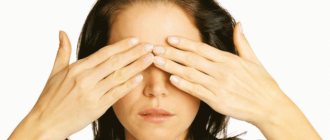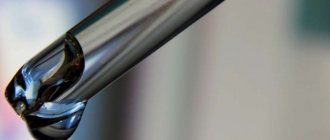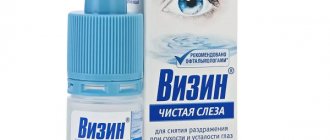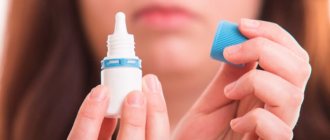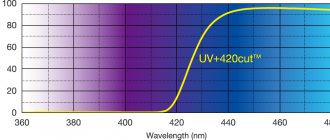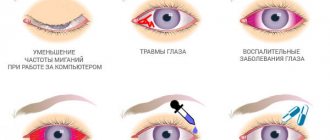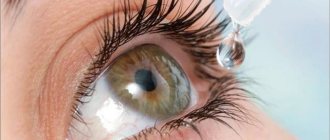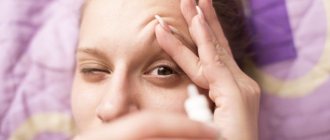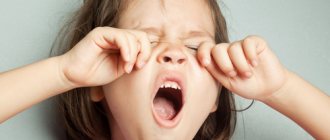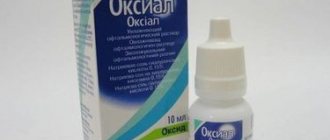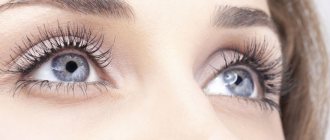Eye fatigue is accompanied by a whole range of symptoms that are characteristic of various ophthalmological diseases. It’s not just prolonged work at the computer that can lead to visual fatigue, as many people believe. There are many other causes of eye fatigue. Let's find out why it occurs and how to deal with it.
Eye fatigue - how does it manifest itself?
In ophthalmology, eye fatigue is called asthenopia - rapid fatigue of the visual organs. This functional disorder is a consequence of prolonged visual stress. Asthenopia is not a pathological process, but this does not mean that it can be left without treatment. Chronic eye fatigue can subsequently lead to severe vision impairment. There are other severe complications of asthenopia.
Eye fatigue as a separate symptom is quite difficult to describe. A person wants to quit work and relax, it is difficult for him to concentrate and concentrate, everything gets boring, he becomes nervous and irritable. It will be easier to understand what visual fatigue is if you describe the signs that accompany this condition. These include:
- redness of the protein membrane with a pronounced vascular network;
- swelling under the eyes, swelling of the eyelids;
- deterioration of vision: decreased visual acuity, appearance of a veil before the eyes, impaired color vision, double vision and other functional disorders;
- dry cornea or, conversely, excessive lacrimation;
- painful sensations when moving the eyeballs in the area of the eye sockets, temples, forehead, eyebrows;
- headaches and dizziness;
- heaviness in the eyes, manifested in involuntary closing of the eyelids;
- sensation of the presence of a foreign body on the mucous membrane.
When the eyes are tired, they lose moisture, the cornea dries out, and the person feels that inflammation is beginning. The eyeballs try to get rid of dryness by secreting tears in large volumes. My eyes are constantly watering. A person rubs them with his hands, irritating the mucous membrane. The risk of pathogenic microorganisms getting onto the surface of the eyeball increases. This can cause an ophthalmological disease of infectious etiology. Signs of asthenopia are accompanied by symptoms of infection. As a result, you will have to give up work completely and go on sick leave. Many infectious eye diseases can lead to severe vision loss. Thus, the signs of asthenopia should never be ignored.
Application area
Such medications help relieve fatigue and conjunctival hyperemia. In addition, they are aimed at relieving irritation, the feeling of a foreign body in the eye, sand and dryness. The relevance of the use of this group of drugs is caused by large-scale computerization and the popularization of gadgets among the younger generation. Constant strain on the eyes leads to a spasm of accommodation, decreased visual acuity, and headaches.
Eye fatigue should be addressed when it first appears.
What causes your eyes to get tired?
Asthenopia can be caused by a variety of reasons. They are not necessarily associated with the organs of vision and ophthalmological pathologies. Some causes are not very dangerous, some of them require urgent treatment. Ophthalmologists identify the following factors that contribute to the development of symptoms of asthenopia:
- lack of visual hygiene;
- Frequent watching of TV, prolonged work at a computer monitor;
- incorrectly selected optics or incorrect mode of operation;
- driving a car for a long time;
- long stays in rooms with dry air, in which air conditioning is running and heating is turned on;
- poor diet and bad habits, including drinking alcohol and smoking;
- refractive errors: myopia, hypermetropia, presbyopia, astigmatism;
- eye diseases of an infectious and inflammatory nature;
- vegetative-vascular dystonia;
- increased pressure (intracranial, intraocular, arterial).
When treating asthenopia, you can directly influence its symptoms or the cause of eye fatigue. If the provoking factor is a vision pathology, it is necessary to treat it. Refractive errors are corrected with high-quality optics selected together with an ophthalmologist, infectious diseases are treated with antibiotics and anti-inflammatory drugs, problems with the vegetative-vascular system are solved through drug therapy and physiotherapeutic procedures. Eye fatigue caused by exposure to external factors on the organs of vision, prolonged visual stress, that is, non-pathological causes, can be eliminated with the help of eye drops. There are other ways to treat asthenopia: eye exercises, taking vitamin complexes, traditional medicine. Let's find out which eye drops are best to use for tired eyes.
Recommendations for use
An undeniable advantage of most drugs is their safety for humans.
However, it is worth remembering that vasoconstrictor drops have many limitations and contraindications. They should not be dripped before driving a car, because due to their characteristics they can temporarily blur your vision. People who have heart problems should also be careful. During pregnancy, taking drugs from the last group is also undesirable. This also applies to those who wear contact lenses, because the transparency of the optics may deteriorate.
In rare cases, there is intolerance to the components of the drug used, so at the first sign of an allergic reaction, you should stop the course of treatment and contact an ophthalmologist to adjust the technique.
No matter how safe the drug is, it is recommended to visit a doctor in any case. This is especially true for drops with a vasoconstrictor effect.
Eyes become very tired and red. Which drops to choose?
Eye drops for eye fatigue are the most effective way to eliminate signs of asthenopia. Their effectiveness lies in the fact that they instantly affect various structures of the eyeball. Tired eye syndrome goes away within a few seconds after instilling the drug. It is worth noting that ophthalmic drops eliminate eye fatigue, but they cannot cure the cause of asthenopia if it lies in any pathology. The purpose of such drugs is to alleviate the human condition.
Eye drops are anti-inflammatory, antibacterial, antihistamine, moisturizing, healing, vitamin, and diagnostic. To treat glaucoma, solutions are used that can lower intraocular pressure. Eye drops for fatigue should have a vasoconstrictor, moisturizing or restorative effect.
Drugs that constrict blood vessels eliminate external signs of fatigue, that is, redness of the sclera. Simultaneously with this symptom, itching, burning, and dryness are relieved. Such products are not classified as medications. They can be instilled when fatigue occurs due to working at the computer or prolonged reading. Drops that restore the tear film usually contain hyaluronic acid or other components that mimic tears. Moisturizing drops are often recommended for office workers, people who wear contact lenses, and patients with hypersensitive corneas.
There are many types of eye drops available in the market. Which ones to choose for eye fatigue? We list the most popular and effective drugs that are approved by doctors.
Inexpensive and effective drops
Low cost and stable, good effect for computer fatigue are typical for the following eye drops:
- Taufon is a domestic drug for nourishing eye tissue, enriching it with vitamins, indicated for retinal dystrophy, corneal injuries, cataracts and glaucoma, as a prophylactic for age-related changes and excessive visual stress;
- Taurine is a cheap substitute for Taufon;
- Polynadim - prescription eye drops to relieve redness and swelling of the eye mucosa;
- Visoptic - a medicine in composition, indications, restrictions on use and treatment features is identical to the original drug Vizin, differs in price - it is approximately 1.5-2 times lower;
- Defislez is a drug for restoring and stabilizing the properties of the tear film, it acts quickly - 2-3 days after instillation, the redness of the mucous membrane decreases, the healing process of damaged eye tissue occurs;
- Licontin Comfort - drops are designed to ensure comfortable wearing of contact lenses, eliminate dryness and eye fatigue during prolonged work at the computer; when instilled, they do not require removal of contact lenses.
Best eye drops for fatigue
The most well-known drugs that fight eye fatigue include:
- Visin is an eye drop that has a vasoconstrictor effect. You can bury them up to three times a day. They have an effect almost instantly.
- "Systane" is a product containing components of natural human tears. After instillation into the eyes, the drops form a film on the surface of the eyeball that protects from drying out. The drug is used 1-2 times a day.
- "Innoxa" - eye drops that have a moisturizing effect. They are suitable for people who have to sit at a computer for hours. You can instill the solution several times a day when signs of fatigue appear.
- "Visomitin." These drops moisturize the cornea, and also improve metabolism and promote tissue healing. They can be prescribed for injuries. Instillation is carried out three times a day.
- "Artelak" - eye drops based on sodium hyaluronate, which saturates the eyes with all the necessary microelements and protects the cornea from adverse environmental factors. You need to instill one drop of solution into each eye 3-5 times a day.
- "Vitafacol" is a drug that helps normalize metabolic processes. Drops have a positive effect on the lens and cornea. This drug is often included as an additional medication in the treatment program for people with cataracts. However, it can also be used for chronic eye fatigue. The solution is instilled three times a day.
- "Blink Intensive" The drug is prescribed for redness of the eyes, but only if this symptom is caused not by pathology, but by excessive visual strain. After instillation, the blood vessels narrow, causing the redness to disappear. There are no chemically active substances in the solution, so you can use it often, focusing on your own feelings.
- "Ophtolik" - moisturizing drops that relieve symptoms of dry eye syndrome. This product contains chemically active substances, so it can be used no more than twice a day.
- "Riboflavin" is a vitamin drop that strengthens the immune system. The drug is used as a prophylactic agent; it prevents the development of ophthalmopathologies. Instillation should be carried out twice a day, morning and evening.
- "Irifrin" - drops with a calming effect. They eliminate redness and other signs of asthenopia. To do this, just drip the solution in the morning. You shouldn't need it anymore during the day.
- "Visor". These drops are similar in composition to Visin, but also include vitamin supplements that strengthen the tissue of the eyeballs. The drug is used in courses. It usually lasts a week. Instillation is carried out four times a day.
- "Visoptic" - eye drops that are ideal for users of contact optics. If eye fatigue occurs while wearing it, you can drip the solution directly on top of the lenses. It is recommended to use Vizoptik for no more than four days in a row.
The best drops for eye allergies for children
Allergies to the eyes in childhood are quite common. Due to the fact that the child’s body has not yet fully formed, it can react negatively to many substances. Therefore, when choosing medications for an allergic reaction, you need to be extremely careful and attentive. Only a doctor can prescribe ophthalmic drops for children. The most commonly recommended drugs are from the following list.
Lecrolin
One of the most effective and safe antiallergic and decongestant ophthalmic agents. The active ingredient of the drug is sodium cromoglycate, aimed at preventing the synthesis of histamine. Lecrolin is prescribed for the prevention and treatment of allergic keratitis, conjunctivitis and keratoconjunctivitis in adults and children over 4 years of age.
Eye drops are well accepted by the body, but in rare cases they can cause burning, itching and decreased clarity of vision.
Do not use the drug if you are hypersensitive to the components or if you are wearing contact lenses.
Opatanol
A selective antihistamine whose active substance is olopatadine hydrochloride. This ophthalmic agent is prescribed for the treatment of seasonal allergic conjunctivitis in adults and children over 3 years of age. You need to instill the solution 1 drop twice a day with an interval of 8 hours.
During treatment of an allergic reaction, the following side effects may occur:
- blurred vision;
- itching, burning;
- keratitis;
- lacrimation;
- swelling of the eyelids.
In rare cases, patients complained of headaches and dizziness, weakness, and nausea.
It is forbidden to use Opatanol if you have hypersensitivity to its drugs.
Ketotifen
An antihistamine ophthalmic agent aimed at slowing down the synthesis of histamine. The effect of Ketotifen is observed within a couple of hours. These eye drops are prescribed for allergic conjunctivitis and keratoconjunctivitis. The solution can be instilled into children from 6 months of age. Do not use the medicine if you have an individual intolerance to its components. Sometimes, when treating eye allergies with Ketotifen, side effects may occur in the form of redness of the eyes, increased sensitivity to light and tearing.
Okumetil
An inexpensive combined ophthalmic agent that contains zinc sulfate, naphazoline and diphenhydramine. The drug blocks the synthesis of histamine receptors and has the following actions:
- anti-inflammatory;
- astringent;
- vasoconstrictor;
- decongestant.
Okumetil is prescribed for the treatment of various types of conjunctivitis, blepharoconjunctivitis and irritation of the eye tissue. The antiallergic drug has the following contraindications:
- dry eye syndrome;
- epilepsy;
- bronchial asthma;
- angle-closure glaucoma;
- diabetes;
- pheochromocytoma;
- heart and vascular diseases.
The solution can be instilled into adults and children over 2 years of age. After instillation, side effects may occur in the form of burning and itching, blurred vision, swelling and hyperemia. Sometimes maculopathy and central scotoma develop.
Another good remedy for treating eye allergies in children is homeopathic drops Similasan.
What other medications are there to relieve eye fatigue when working at a computer?
The list of best drops listed above is not exhaustive. These are the most popular drugs. There are other drops that are not so effective, but are absolutely safe. They do not contain strong components, so they can be used frequently. In addition, they cost much less. Among these drugs:
"Oxial" - drops based on sodium hyaluronate. They are biocompatible with eye tissue. Use the product up to 5-6 times a day as needed. “Oftagel” are drops that form a protective layer on the surface of the eye that does not come into contact with the tear fluid, but does not allow it to evaporate. "Octilia" is a drug used to treat redness and eye fatigue that occurs when working at a computer. Drops are instilled up to three times a day. “Natural tear” is a solution that has a moisturizing effect. It is the most harmless in its composition. It cannot be called very effective for relieving eye fatigue, but it is absolutely harmless and the most inexpensive.
The best drugs
The best medications to relieve eye strain are from the following list:
- Ophtolic;
- Visine;
- Artelak;
- Systane;
- Visomitin;
- Visoptic;
- Riboflavin;
- Irifrin;
- Emoxipin;
- Visor.
Ophtolic
Oftolik is produced in India. The medicine contains povidone and belongs to the category of keratoprotectors. The product helps to get rid of irritation, fatigue, and promotes good eye hydration. This medication costs about 395 rubles.
Visine
Visine is a drug for increased eye strain, produced in Canada and France. A product containing tetrizoline causes vasoconstriction and eliminates swelling. The price of this product is from 300 rubles.
Artelak
Artelak - German drops containing hyaluronic acid. The drug eliminates even severe dryness of the eyeballs and helps maintain the normal state of the tear film. You can buy this solution for 461 rubles.
Systane
The Spanish medicine Systane, prescribed for irritated and dry eyes, costs about 200 rubles. This product contains several active substances (boric acid, zinc, calcium, polydronium chlorides and other components).
Visomitin
Visomitin is a keratoprotective solution, the country of manufacture of which is the Russian Federation. These drops contain plastoquinonyldecyltriphenylphosphonium bromide as well as additional ingredients. Product price – from 530 rub.
Visoptic
Visoptic is produced by Romanian manufacturers. A medicine containing tetrizoline effectively eliminates the effects of visual overload and relieves redness. The cost of drops in pharmacies is 230 rubles.
Riboflavin
Riboflavin is an inexpensive drug that helps combat visual fatigue. The solution is produced by pharmaceutical companies in Russia and Belarus and contains a substance with the same name as its main component. Riboflavin has a low price - from 90 rubles.
Irifrin
The base of Irifrin drops is phenylephrine. The remedy for fatigue and red eyes is of Indian origin and has vasoconstrictor properties. This solution costs around 600 rubles.
Emoxipin
Emoxipine is produced in Russia and Estonia. The drug contains methylethylpyridinol, is an active angioprotector and antioxidant, helps prevent and eliminate hemorrhages in the eyeball. This medication has an affordable price - from 145 rubles.
Visor vitamin drops contain aloe extract, carotene, vitamins A and E. The drug is effective for fatigue and excessive dryness of the visual organs. The price of medication for eye drops is as affordable as possible - about 70 rubles.
Are there any contraindications to anti-fatigue eye drops?
Such solutions, as a rule, have no contraindications, since they do not contain preservatives or other aggressive components. Side effects, if they occur after their instillation, are in the form of an allergic reaction, which is difficult to predict. If discomfort in the eyes occurs, you should stop taking the drug and visit an ophthalmologist. Despite the almost complete harmlessness of eye drops for fatigue, they are not prescribed for:
- high blood pressure;
- fragility of blood vessels, which is accompanied by hemorrhages;
- bronchial asthma;
- eye allergies;
- problems with blood clotting.
Types and groups of eye drops
Depending on the purpose and composition of the drug, drops are divided into types and groups:
These are the requirements that eye drops for dryness and fatigue must meet.
| Types of drops | Groups | a brief description of |
| Anti-inflammatory | Steroid | Prescribed for bacterial inflammatory processes. Does not destroy the pathogen, relieves symptoms before the eyes |
| Non-steroidal | Used for inflammation caused by viruses and allergic reactions | |
| Combined | Prescribed for inflammation of various infectious natures. Have a healing effect | |
| Anti-allergenic | — | Relieves allergy symptoms (itching, swelling, lacrimation). They do not eliminate the allergy itself. Must be used as a course |
| Antimicrobial | Antibacterial | Used in the treatment of eye pathologies caused by bacteria |
| Antiviral | Drops destroy viruses that cause eye disease | |
| Antifungal | Prescribed to destroy fungus | |
| Combined | Drops destroy bacteria and viruses | |
| Antiseptic | Used to destroy infections of any nature (viruses, bacteria, fungi) | |
| For the treatment of glaucoma | To improve fluid outflow | Normalizes the balance of fluids in the anterior and posterior chambers of the eyes, thereby reducing intraocular pressure |
| To reduce the production of intraocular fluid | ||
| For the treatment of cataracts | — | Helps slow down the development of the disease. The disease itself is not treated |
| Vasoconstrictors | — | They are used once to relieve swelling, redness and reduce lacrimation. Prolonged use is prohibited |
| Diagnostic | — | Used by ophthalmologists to dilate the pupil when examining the fundus |
| Moisturizing | — | To moisturize the mucous membrane of the eye with increased dryness |
| Restoring or healing | — | Restore tissue and functioning of the eyes. Normalize metabolism |
| Vitamin | — | Prescribed to restore vision in cases of myopia, cataracts, glaucoma |
| Drops for dryness and fatigue | — | Helps restore vision and moisturize thanks to the vitamins it contains. They have a therapeutic effect, so they can be used as prevention and treatment |
| When wearing lenses | — | Relieves redness, fatigue and moisturizes eyes |
Each type of drop has its analogues. If the drug causes discomfort or the development of side effects, then it is replaced by a specialist. Replacing it yourself can lead to vision loss.
Recommendations for use
There are a number of recommendations from specialists that are important to follow regardless of which drug will be used. So:
- Self-medication is excluded! Various factors can provoke dryness, redness and other unpleasant manifestations - lack of sleep, allergic reactions, age-related changes. Whatever it is, it is necessary to consult with an ophthalmologist, based on the results of an eye examination, the optimal treatment option will be prescribed, and factors that are contraindications for the use of a particular drug will be excluded. It is especially important to obtain a doctor’s approval when using eye drops for fatigue and tension during pregnancy and lactation, and if you are prone to allergic reactions. You also need to take into account that a number of drugs from this segment can only be used by patients over 18 years of age.
- Shelf life and sterility. Be sure to pay attention to the production dates of ophthalmic products indicated on the packaging, and carefully ensure that opened drops are not used for more than 3 months. They should be stored in a cool and dark place, hermetically sealed. Some products have a shelf life of 1 month if storage rules are followed. It is often recommended to store opened drops in the refrigerator. Of course, under no circumstances should you use expired drops for dry eyes. And when instilling and storing ophthalmic drugs, it is necessary to ensure their maximum sterility.
- Frequency of use. If you do not use eye drops daily, it is more convenient to purchase soft dropper tubes for single use. They take up almost no space, making it an ideal option to take with you on a trip. If you use drops often or even daily, choose the composition in a plastic bottle with a special thin spout that allows you not to use a pipette.
- Important. Almost any drug for dry eyes will become addictive if used over a long period of time and will not be as effective as when first used. It is quite possible to choose an alternative option; the line of drops is constantly expanding.
In addition to the listed causes of dryness and redness of the mucous membrane of the eyes, there are a number of conditions that can only be eliminated with a comprehensive examination and general therapeutic treatment. These include:
- hormonal disorders;
- myopia, astigmatism, farsightedness;
- frequent surges in blood pressure;
- neoplasms of various etiologies;
- age-related changes in the body;
- pregnancy and postpartum period.
In these cases, the use of drops to eliminate dry eyes must be combined with medications prescribed by a qualified doctor.
Are there any methods of drug prevention of dryness and irritation of the eyes for those who are forced to work a lot with texts, small objects, or often drive a vehicle due to the nature of their profession?
Without a doubt, there are many ways to maintain eye health and comfort when wearing optics today. Ophthalmologists prescribe vitamin drops for the eyes, which will be useful for both adults and children. Such funds are needed to prevent visual impairment and strengthen eye tissues when:
- long-term work requiring constant visual strain;
- visual impairments – myopia, astigmatism, farsightedness;
- after 45-50 years, since by this age the first signs of aging of the visual organs often appear.
The use of special drops will improve the condition of all eye membranes and delay the appearance of age-related complications:
- "Visiomax". The drops contain extracts of plants and berries (parsley, carrots, black currants, blueberries and a number of others). The positive effect of these plants on increasing visual acuity has been known for a long time. The complex thins the blood well, so it is recommended if you are prone to blood clots.
- "VitA-POS". Vitamin A, which is part of the drops, has a softening effect and forms a viscous lubricating film. Thanks to these properties, the drops protect the cornea from drying out.
- "Taufon". Taurine is the main component in the drops, which prevents blood clots, normalizes glucose levels in diabetes, and accelerates metabolism in the tissues of the visual organs. "Taufon" helps normalize intraocular pressure and prevents the development of dystrophic processes.
Suitable types of drops
If you are tired, it is advisable to use the following eye drops:
- vasoconstrictors;
- moisturizing;
- restorative.
In addition, sedatives may be prescribed. Their main task: to calm the connective membrane (conjunctiva). They can eliminate irritation or itching, but for dry eye syndrome they are not considered a qualitatively primary therapeutic agent.
Vasoconstrictors
Alpha adrenergic agonists, which have a vasoconstrictor effect, will help with red eyes. The following drugs are popular:
- Visine classic. In order to relieve swelling and redness of the conjunctiva, these drops are prescribed starting from the age of two. Relief occurs within 1 minute after instillation and continues for 4–8 hours.
- Vial Light. When secondary hyperemia appears due to exposure to external stimuli, these drops are prescribed to temporarily eliminate symptoms. The therapeutic effect develops 2-3 minutes after instillation and lasts up to 4 hours.
- Visoptician. When these drops are instilled into the conjunctival sac, the walls of the blood vessels narrow, which leads to a decrease in redness and swelling of the conjunctiva.
Moisturizing
Ophthalmic solutions with a moisturizing effect are also popular with people who sit at the computer for a long time or use other gadgets. Such means include:
- Oksial;
- Hilo Chest;
- Hilabak.
These drops contain sodium salt of hyaluronic acid. This is a natural substance that is a physiological polysaccharide contained both in the eyeball and in other structures of the human body.
If a person complains of a burning sensation, a feeling of dryness or the presence of a foreign body, then such remedies can remove the listed discomfort due to additional hydration of the anterior segment of the eyeball. How often to instill eyes with moisturizing solutions depends on the subjective feelings of the patient and the recommendations of the ophthalmologist.
Restorative
The best drops for tired eyes are keratoprotectors. They stimulate tear production, epithelization, and also help increase the stability of the substance covering the cornea. The following restorative drops are popular:
- Visomitin;
- Hypromelose;
- Lakrisifi;
- Ophtolic;
- Slesin.
The main effect of keratoprotectors is to soften and lubricate. Due to their increased viscosity, their contact with the cornea becomes longer. The medicinal solution has a similar refraction as natural tears. This contributes to the restoration and further stability of the optical characteristics of the substance covering the cornea.
